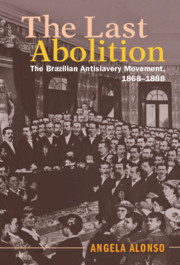Book contents
- The Last Abolition
- Afro-Latin America
- The Last Abolition
- Copyright page
- Dedication
- Contents
- Figures
- Maps
- Tables
- Acknowledgments
- Abbreviations
- Introduction
- 1 Elite Abolitionism
- 2 Pro-Slavery Rhetoric
- 3 The Moral Repertoire of Abolitionism
- 4 The Theatricalization of Politics
- 5 Expansion
- 6 Results-Based Abolitionism
- 7 Votes: A Movement/Government Alliance
- 8 Bullets: Movement and Countermovement
- 9 The March to Victory
- 10 Future of the Preterite
- 11 Abolitionism as a Social Movement
- Annex
- Bibliography
- Index
3 - The Moral Repertoire of Abolitionism
Published online by Cambridge University Press: 24 September 2021
- The Last Abolition
- Afro-Latin America
- The Last Abolition
- Copyright page
- Dedication
- Contents
- Figures
- Maps
- Tables
- Acknowledgments
- Abbreviations
- Introduction
- 1 Elite Abolitionism
- 2 Pro-Slavery Rhetoric
- 3 The Moral Repertoire of Abolitionism
- 4 The Theatricalization of Politics
- 5 Expansion
- 6 Results-Based Abolitionism
- 7 Votes: A Movement/Government Alliance
- 8 Bullets: Movement and Countermovement
- 9 The March to Victory
- 10 Future of the Preterite
- 11 Abolitionism as a Social Movement
- Annex
- Bibliography
- Index
Summary
In the 1870s the growth of urbanization, the expanded access to tertiary education, and the reduced printing costs broadened the range of participants in the public debate in Brazil. Abolitionists addressed this public with the rhetoric of change. The Brazilian moral repertoire emulated former abolitionist movements rationale, presenting abolition as an act of compassion, a right, and a sign of progress. However, differently from the Anglo-American case, Brazilians scarcely relied on religious arguments, instead employing scientific and artistic language for increasing the awareness of its urban audience. This rhetoric was used by all abolitionists, with distinctive emphasis. The black abolitionist Luís Gama was responsible for the diffusion of a style of activism heavily based on the rhetoric of rights. Gama started freedom lawsuits, later emulated all over the country. In contrast with Abílio Borges and Andre Rebouças, Gama was an elite outsider and attracted non-elite members to abolitionist activism. At this point, Rebouças recognized a similarity to him: traveling to the US, he was not regarded as an aristocrat, unlike in Europe, but as a black man. He then took Frederick Douglass as a model to fight slavery.
- Type
- Chapter
- Information
- The Last AbolitionThe Brazilian Antislavery Movement, 1868–1888, pp. 85 - 108Publisher: Cambridge University PressPrint publication year: 2021



